新编实用英语综合教程(第四版)Unit2教案详解
- 格式:doc
- 大小:109.00 KB
- 文档页数:17
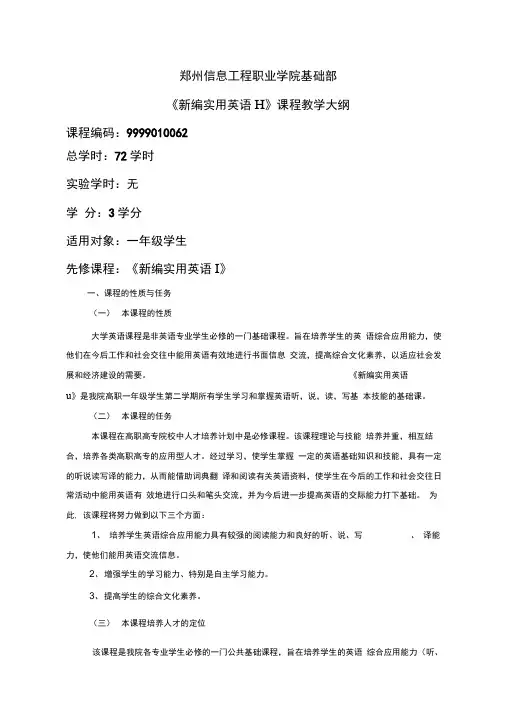
郑州信息工程职业学院基础部《新编实用英语H》课程教学大纲课程编码:9999010062总学时:72学时实验学时:无学分:3学分适用对象:一年级学生先修课程:《新编实用英语I》一、课程的性质与任务(一)本课程的性质大学英语课程是非英语专业学生必修的一门基础课程。
旨在培养学生的英语综合应用能力,使他们在今后工作和社会交往中能用英语有效地进行书面信息交流,提高综合文化素养,以适应社会发展和经济建设的需要。
《新编实用英语u》是我院高职一年级学生第二学期所有学生学习和掌握英语听,说,读,写基本技能的基础课。
(二)本课程的任务本课程在高职高专院校中人才培养计划中是必修课程。
该课程理论与技能培养并重,相互结合,培养各类高职高专的应用型人才。
经过学习,使学生掌握一定的英语基础知识和技能,具有一定的听说读写译的能力,从而能借助词典翻译和阅读有关英语资料,使学生在今后的工作和社会交往日常活动中能用英语有效地进行口头和笔头交流,并为今后进一步提高英语的交际能力打下基础。
为此, 该课程将努力做到以下三个方面:1、培养学生英语综合应用能力具有较强的阅读能力和良好的听、说、写、译能力,使他们能用英语交流信息。
2、增强学生的学习能力、特别是自主学习能力。
3、提高学生的综合文化素养。
(三)本课程培养人才的定位该课程是我院各专业学生必修的一门公共基础课程,旨在培养学生的英语综合应用能力(听、说、读、写、译),使他们在今后工作中与社会交往中能用英语有效地进行信息交流,提高综合文化素养,以适应社会发展日益国际化的需要。
(四)本课程在人才培养过程中的作用经过本课程的学习,使学生扎实语音、语法、词汇和基本句型等语言基本功,强化并提高听、说、读、写、译的综合能力,提高学生就业竞争力。
二、课程的基本要求通过学习本课程,学生应该达到以下要求:1、词汇认知2500个英语单词(包括入学时要求掌握的1000个词)以及由这些词构成的常用词组,对其中1500个左右的单词能正确拼写,能进行英汉互译。
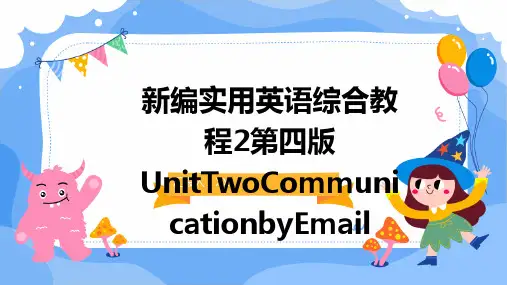
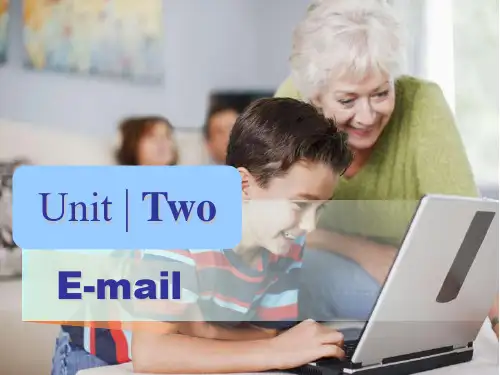
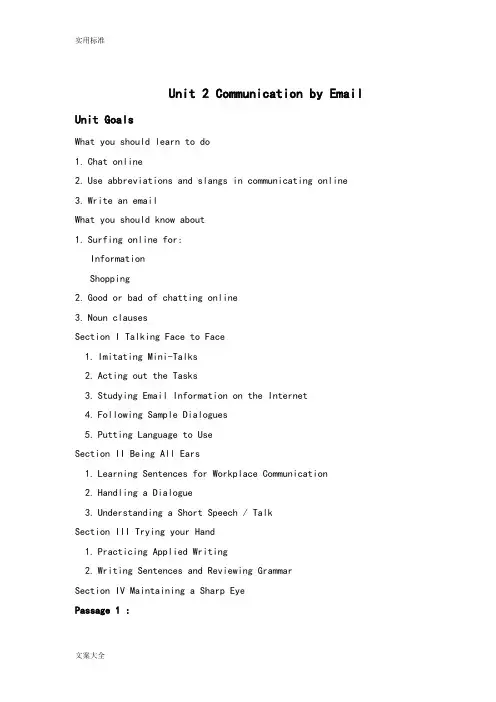
Unit 2 Communication by Email Unit GoalsWhat you should learn to do1.Chat onlinee abbreviations and slangs in communicating online3.Write an emailWhat you should know about1.Surfing online for:InformationShopping2.Good or bad of chatting online3.Noun clausesSection I Talking Face to Face1.Imitating Mini-Talks2.Acting out the Tasks3.Studying Email Information on the Internet4.Following Sample Dialogues5.Putting Language to UseSection II Being All Ears1.Learning Sentences for Workplace Communication2.Handling a Dialogue3.Understanding a Short Speech / TalkSection III Trying your Hand1.Practicing Applied Writing2.Writing Sentences and Reviewing GrammarSection IV Maintaining a Sharp EyePassage 1 :Information Related to the Reading PassageIt’s no understatement to say that e-mail has had a profound effect on our professional and personal lives. People thousands of miles away from each other can send and receive detailed documents within mere seconds. This allows us to take on projects that wouldn’t have been practical or possible only a few years ago. It has become routine for us to correspond and exchange files with people overseas. The only obstacle is the difference in time zones.But on the other hand, e-mail can eat up a substantial portion of our workday. Most of the time and effort involved is going through unsolicited messages and separating the good from the bad. But not all unsolicited messages are spam.Text E-mail, a Blessing and AnnoyanceFor the blessing:E-mail is a conversation that does not require an immediate response (like a telephone). If someone calls you on the telephone, you pick it up (unless you have an answering machine, voice mail or you are just plain rude) and the conversation begins. This is an interactive conversation. With e-mail, you send a message and then wait for a response. The response may come in five minutes or it may come in five days. Either way, it’s not an interactive conversation.If a hundred people send you e-mails in one day, so what? You don’t have to talk with all one hundred. Just think of all the hellos, goodbyes and other unnecessary chit-chat you can avoid. With e-mail, you only deal with their messages (which usually omit hellos, goodbyes and such) and you deal with them on your own time. That’s the blessing.Now for the annoyance:Too many e-mail users assume that the minute someone receives ane-mail, the person will read it. Bad assumption.If you schedule a meeting for an hour from now and send an e-mail to each participant, the chance that all the participants will read that message within the hour will be pretty small. On the other hand, if you schedule the meeting for the next day, the chance that they will read the message will be pretty high. Remember, e-mail is not designed for immediate response (that’s why you have a telephone), it’s designed for convenience.Some (not all) e-mail systems have features that try to combat this problem. These features (usually called “notification”) will notify you when a person has received your e-mail and may also tell you when the person has read it (really all it can do is assure you that the person has looked at the first screen of the message — it has no way to know if the person has read the message word for word). Referring back to the example in the previous paragraph, you could check to see who has checked their e-mail before the meeting and then telephone those who have not read it.Attachment: SmiliesSince there are no facial and voice cues to help e-mail, users have come up with something called “smilies”. They are simple series of symbols that are pieced together in the e-mail text to help express the writer’s feelings. The most common example is :-) (a smiling face). Here are some more examples.They are typically found at the end of sentences and will usually refer back to the previous statement.Language Points1 Explanation of Difficult Sentences1. (Para. 3) If a hundred people send you e-mail in one day, so what?Analysis: so what? is an informal expression, which means “ Why should I care?”Translation: 如果在一天内有一百个人给你发邮件,那又怎么样呢?2. (Para. 3) Just think of all the hellos, good-byes and other unnecessary chit-chat you could avoid.Analysis: Just is used to make a statement or command stronger, meaning in Chinese “只是,仅仅”。
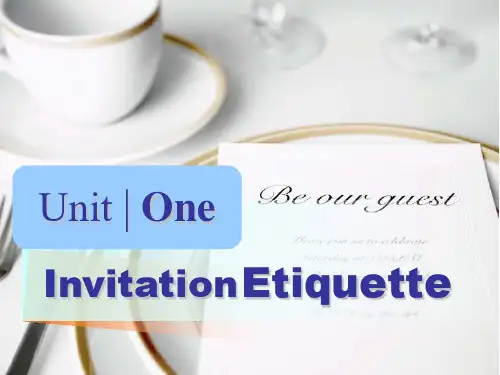
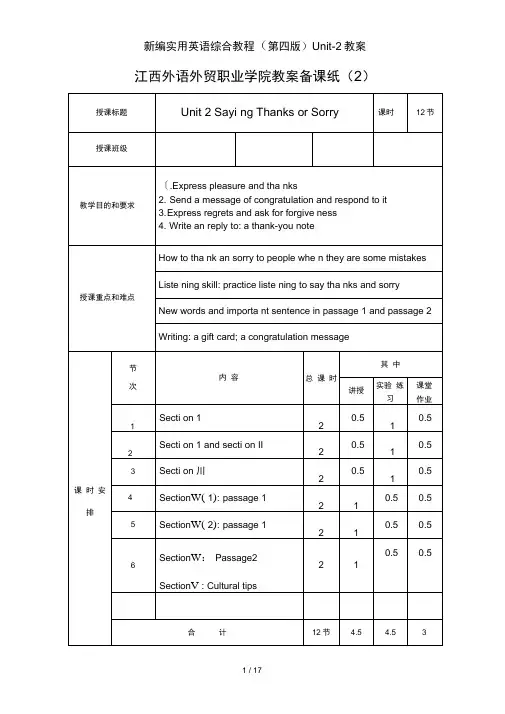
新编实用英语综合教程(第四版)Unit-2教案江西外语外贸职业学院教案备课纸(2)新编实用英语综合教程(第四版)Unit-2教案主任审阅年月日授课教师年月日江西外语外贸职业学院教案备课纸(3)新编实用英语综合教程(第四版)Unit-2 教案江西外语外贸职业学院教案备课纸(4)授课内容Unit 2Section I Talking Face to FaceThe topic of talking face to face area in this unit is to express thanks and give responseswhile exchanging gift-card and congratulation card. The focus is on the patterns that are appropriate for giving information concerning the various reasons and hoping to get the forgiveness from the other person.1. The students read the mini-talks after the teacher, and then try to recite them within five minutes in pairs.2. Ask the students to underline the useful expressions and perform the mini-talks in class.3. The students discuss in groups, summarizing the words, phrases and sentences frequently used according to the following topics with the help of the teacher. The students speak out the sentences under the guidance of the teacher, paying attention to the pronunciation and the intonation.1) sentences frequently used for expressing thanks:It was so generous of you to send me such a fine and beautiful gift.I don 't know how to express my thanks to you.I 'm grateful for all the help and encouragement you've given me.2) Sentences frequently used for expressing congratulations:Congratulations on your recent promotion!Please accept my heartiest congratulations.新编实用英语综合教程(第四版)Unit-2教案主任审阅年月日授课教师年月日江西外语外贸职业学院教案备课纸(3)新编实用英语综合教程(第四版)Unit-2 教案江西外语外贸职业学院教案备课纸(4)授课内容Unit 2Section II Being All Ears1. Give the students a few minutes to read through the printed materials for each listening item.2. Listen to the material for the first time without referring to the book.3. Listen to the material for a second time, and ask the students to answer the following questions orally.1) What is the relationship between Andy and Donna?2) What happened to Donna? How does she feel now?3) Why does Donna show her thanks to Andy?4) Where does Andy get the flowers?5) Where does Donna keep the flowers?主任审阅年月日授课教师年月日江西外语外贸职业学院教案备课纸(3)江西外语外贸职业学院教案备课纸(4)授课内容Secti on 皿Tryi ng Y our HandApplied WritingSample An alysisThe teacher summarizes briefly the format and Ianguage used in thank-you notes, con gratulati on cards and apology letters. The teacher may show the follow ing passage with PPT. Afterwards, ask the students to read it and translate it into Chinese orally. 1. More information about thank-you notes;Than k-you no tes are usually excha nged betwee n frie nds and acqua intan ces.They are brief, direct and ofte n in an in formal style. They are ofte n writte n insimple Ian guages, using courteous words and senten ces to express the writ'good wish or tha nks. The follow ing senten ces are ofte n used in tha nk-you no tes.2. More information about congratulation cards:People often write and send a congratulation card to congratulate one on suchjoyful occasions as celebrating one's promotion, wedding, birthday, graduation, etc.Con gratulati on cards are also excha nged on holidays. The Ian guage used in a con gratulatio n card usually sounds courteous and complime ntary. The followi ng expressi ons and senten ces ofte n appear in con gratulati on cards.Grammar3. Assig nment for this sect ionWritte n work: suppose you missed an appo in tme nt with your frie nd. Please write a letter of apology for his/her forgive ness.新编实用英语综合教程(第四版)Unit-2教案江西外语外贸职业学院教案备课纸(3)主任审阅 ______________________ 授课教师______________________新编实用英语综合教程(第四版)Unit-2 教案江西外语外贸职业学院教案备课纸(4)授课内容Unit 2Secti on IV (1): Passage 1 Thank you, Volun teers!1. Information Traditional Festivals in China.春节:Spring Festival ( the 1st day of the 1st lunar month) 除夕:New Year's Eve ( the day before the Spring Festival) 元宵节:Lantern Festival ( the 15th of the 1st lunar month) 清明节:Qingming/Tomb-Sweeping Festival (April 4th or 5th) 端午节:Dragon Boat Festival( the 5the of the 5th lunar month) 七夕节:Qixi Festival( the 7 th day of the 7the month of the lunar month, somewhat equivalent to Valentine's Day in English)中秋节:Mid-Autumn Festival( the 15th of the 8th lunar month) 重阳节:Double-Ninth Day ( the 9th of the 9th lunar month)2. Important Traditional Festivals in Western Countries.圣诞节:Christmas( the 25th of December) 平安夜: Christmas Eve ( the 24th of December) 情人节:Valentine's Day ( 14th of February) 愚人节:Fool's Day ( the 1st of April) 复活节:Easter( the 1st Sunday after a full moon on or after 21st of Marth) 感恩节:Thanksgiving Day ( the 4th Thursday f November) 万圣节:Halloween/All Saints'Day (31st of October)Important words1. offerv. make available or accessible, provide or furnishe.g. The conference centeroffers a health spa.The local studentoffers to guide us around the city.2. invitev. ask someone in a friendly way to do somethinge.g. Shall we invite the famous football player to join our club? Students areinvited tosubmit papers to this online magazine.新编实用英语综合教程(第四版)Unit-2 教案3. gratefula. feeling or showing thankse.g. He felt so grateful to all the strangers'help.We need to feel more grateful for what we have instead of complaining what we don't.4. breakn. a pause from doing something ( as work)e.g. The meeting was too long, so we had a tebareak .A 10-minute break between each session offers us a time to rest a bit.5. appreciatev. be fully aware of;; realize fullye.g. Do you appreciate the full meaning of this letter?I do appreciate what you have done to ease my pain.6. recognizev. show approval or appreciation ofe.g. Our effort is fully recognized by the society.The in-service training center is widely recognized here.新编实用英语综合教程(第四版)Unit-2教案江西外语外贸职业学院教案备课纸(3)主任审阅______________________年月日授课教师 ______________________年月日新编实用英语综合教程(第四版)Unit-2 教案江西外语外贸职业学院教案备课纸(4)授课内容Unit 2Section IV (2): Passage 1 Thank you, Volunteers!Language pointsExplanation of Difficult Sentences1. (Para. 1) November in the United States brings the holiday of Thanksgiving, and therefore it's in November that we tend to think of a way in which we could show our thanks to volunteers.Analysis: This is a complex sentence. The basic sentence structure is S(subject) and S in which …I n the sec ondan d-clause an emphatic structureet sinNovemberis used to emphasize the time adverbial of in November,modifying we tend to think. Which leads a relative clause, modifying away.Translation: 因此,我们在十一月里常常会想办法来表示对志愿者们的感谢。
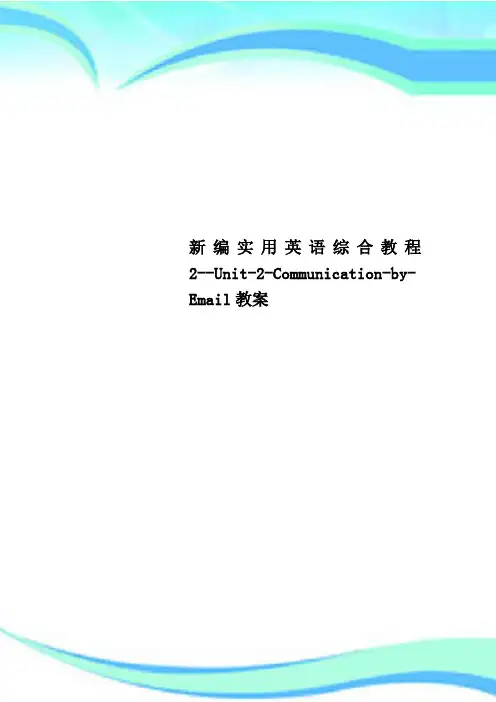
新编实用英语综合教程2--Unit-2-Communication-by-Email教案————————————————————————————————作者:————————————————————————————————日期:Unit 2 Communication by Email Unit GoalsWhat you should learn to do1.Chat onlinee abbreviations and slangs in communicating online3.Write an emailWhat you should know about1.Surfing online for:InformationShopping2.Good or bad of chatting online3.Noun clausesSection I Talking Face to Face1.Imitating Mini-Talks2.Acting out the Tasks3.Studying Email Information on the Internet4.Following Sample Dialogues5.Putting Language to UseSection II Being All Ears1.Learning Sentences for Workplace Communication2.Handling a Dialogue3.Understanding a Short Speech / TalkSection III Trying your Hand1.Practicing Applied Writing2.Writing Sentences and Reviewing GrammarSection IV Maintaining a Sharp EyePassage 1 :Information Related to the Reading PassageIt’s no understatement to say that e-mail has had a profound effect on our professional and personal lives. People thousands of miles away from each other can send and receive detailed documents within mere seconds. This allows us to take on projects that wouldn’t have been practical or possible only a few years ago. It has become routine for us to correspond and exchange files with people overseas. The only obstacle is the difference in time zones.But on the other hand, e-mail can eat up a substantial portion of our workday. Most of the time and effort involved is going through unsolicited messages and separating the good from the bad. But not all unsolicited messages are spam.Text E-mail, a Blessing and AnnoyanceFor the blessing:E-mail is a conversation that does not require an immediate response (like a telephone). If someone calls you on the telephone, you pick it up (unless you have an answering machine, voice mail or you are just plain rude) and the conversation begins. This is an interactive conversation.With e-mail, you send a message and then wait for a response. The response may come in five minutes or it may come in five days. Either way, it’s not an interactive conversation.If a hundred people send you e-mails in one day, so what? You don’t have to talk with all one hundred. Just think of all the hellos, goodbyes and other unnecessary chit-chat you can avoid. With e-mail, you only deal with their messages (which usually omit hellos, goodbyes and such) and you deal with them on your own time. That’s the blessing.Now for the annoyance:Too many e-mail users assume that the minute someone receives an e-mail, the person will read it. Bad assumption.If you schedule a meeting for an hour from now and send an e-mail to eachparticipant, the chance that all the participants will read that message within the hour will be pretty small. On the other hand, if you schedule the meeting for the next day, the chance that they will read the message will be pretty high. Remember, e-mail is not designed for immediate response (that’s why you have a telephone), it’s designed for convenience.Some (not all) e-mail systems have features that try to combat this problem. These features (usually called “notification”) will notify you when a person has received your e-mail and may also tell you when the person has read it (really all it can do is assure you that the person has looked at the first screen of the message —it has no way to know if the person has read the message word for word). Referring back to the example in the previous paragraph, you could check to see who has checked their e-mail before the meeting and then telephone those who have not read it.Attachment: SmiliesSince there are no facial and voice cues to help e-mail, users have come up with something called “smilies”. They are simple series of symbols that are pieced together in the e-mail text to help express the writer’s feelings. The most common example is :-) (a smiling face). Here are some more examples.They are typically found at the end of sentences and will usually refer back to the previous statement.Language Points1 Explanation of Difficult Sentences1. (Para. 3) If a hundred people send you e-mail in one day, so what?Analysis: so what? is an informal expression, which means “Why should I care?”Translation: 如果在一天内有一百个人给你发邮件,那又怎么样呢?2. (Para. 3) Just think of all the hellos, good-byes and other unnecessary chit-chat you could avoid.Analysis: Just is used to make a statement or command stronger, meaning in Chinese“只是,仅仅”。
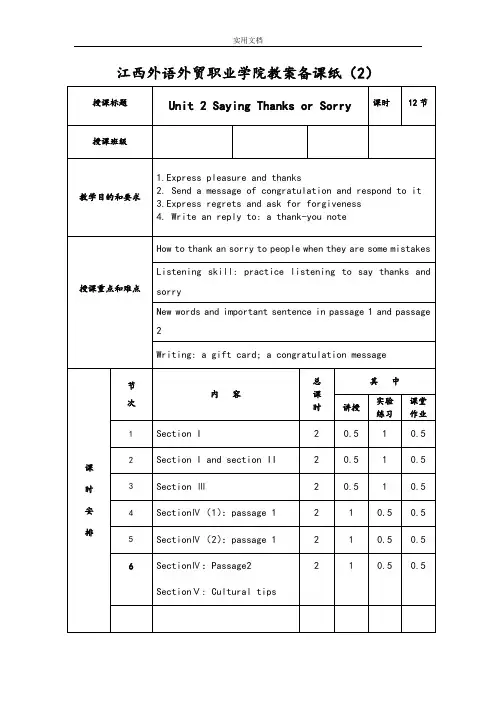
江西外语外贸职业学院教案备课纸(2)江西外语外贸职业学院教案备课纸(3)主任审阅____________________ 授课教师____________________年月日年月日江西外语外贸职业学院教案备课纸(4)授课内容Unit 2Section I Talking Face to FaceThe topic of talking face to face area in this unit is to express thanks and give responses while exchanging gift-card and congratulation card. The focus is on the patterns that are appropriate for giving information concerning the various reasons and hoping to get the forgiveness from the other person.1. The students read the mini-talks after the teacher, and then try to recite them within five minutes in pairs.2. Ask the students to underline the useful expressions and perform the mini-talks in class.3. The students discuss in groups, summarizing the words, phrases and sentences frequently used according to the following topics with the help of the teacher. The students speak out the sentences under the guidance of the teacher, paying attention to the pronunciation and the intonation.1) sentences frequently used for expressing thanks:It was so generous of you to send me such a fine and beautiful gift.I don’t know how to express my thanks to you.I’m grateful for all the help and encouragement you’ve given me.2) Sentences frequently used for expressing congratulations:Congratulations on your recent promotion!Please accept my heartiest congratulations.江西外语外贸职业学院教案备课纸(3)主任审阅____________________ 授课教师____________________年月日年月日江西外语外贸职业学院教案备课纸(4)授课内容Unit 2Section Ⅱ Being All Ears1. Give the students a few minutes to read through the printed materials for each listening item.2. Listen to the material for the first time without referring to the book.3. Listen to the material for a second time, and ask the students to answer the following questions orally.1) What is the relationship between Andy and Donna?2) What happened to Donna? How does she feel now?3) Why does Donna show her thanks to Andy?4) Where does Andy get the flowers?5) Where does Donna keep the flowers?江西外语外贸职业学院教案备课纸(3)主任审阅____________________ 授课教师____________________年月日年月日江西外语外贸职业学院教案备课纸(4)授课内容Section Ⅲ Trying Your HandApplied WritingSample AnalysisThe teacher summarizes briefly the format and language used in thank-you notes, congratulation cards and apology letters. The teacher may show the following passage with PPT. Afterwards, ask the students to read it and translate it into Chinese orally.1.More information about thank-you notes;Thank-you notes are usually exchanged between friends and acquaintances. They are brief, direct and often in an informal style.They are often written in simple languages, using courteous words and sentences to express the writer’s good wish or thanks. The following sentences are often used in thank-you notes.2.More information about congratulation cards:People often write and send a congratulation card to congratulate one on such joyful occasions as celebrating one’s promotion, wedding, birthday, graduation, etc. Congratulation cards are also exchanged on holidays. The language used in a congratulation card usually sounds courteous and complimentary. The following expressions and sentences often appear in congratulation cards.Grammar3.Assignment for this sectionWritten work: suppose you missed an appointment with your friend.Please write a letter of apology for his/her forgiveness.江西外语外贸职业学院教案备课纸(3)主任审阅____________________ 授课教师____________________年月日年月日江西外语外贸职业学院教案备课纸(4)授课内容Unit 2Section Ⅳ(1): Passage 1 Thank you, Volunteers!rmation Traditional Festivals in China.春节:Spring Festival ( the 1st day of the 1st lunar month)除夕:New Year’s Eve ( the day before the Spring Festival)元宵节:Lantern Festival ( the 15th of the 1st lunar month)清明节:Qingming/Tomb-Sweeping Festival (April 4th or 5th)端午节:Dragon Boat Festival( the 5the of the 5th lunar month)七夕节:Qixi Festival( the 7th day of the 7the month of the lunar month, somewhat equivalent to Valentine’s Day in English)中秋节:Mid-Autumn Festival( the 15th of the 8th lunar month)重阳节:Double-Ninth Day ( the 9th of the 9th lunar month)2.Important Traditional Festivals in Western Countries.圣诞节:Christmas( the 25th of December)平安夜: Christmas Eve ( the 24th of December)情人节:Valentine’s Day ( 14th of February)愚人节:Fool’s Day ( the 1st of April)复活节:Easter( the 1st Sunday after a full moon on or after 21st of Marth) 感恩节:Thanksgiving Day ( the 4th Thursday f November)万圣节:Halloween/All Saints’ Day (31st of October)Important words1.offerv. make available or accessible, provide or furnishe.g. The conference center offers a health spa.The local student offers to guide us around the city.2. invitev. ask someone in a friendly way to do somethinge.g. Shall we invite the famous football player to join our club?Students are invited to submit papers to this online magazine.3. gratefula. feeling or showing thankse.g. He felt so grateful to all the strangers’ help.We need to feel more grateful for what we have instead of complaining what we don’t.4.breakn. a pause from doing something ( as work)e.g. The meeting was too long, so we had a tea break.A 10-minute break between each session offers us a time to resta bit.5. appreciatev. be fully aware of;; realize fullye.g. Do you appreciate the full meaning of this letter?I do appreciate what you have done to ease my pain.6. recognizev. show approval or appreciation ofe.g. Our effort is fully recognized by the society.The in-service training center is widely recognized here.江西外语外贸职业学院教案备课纸(3)主任审阅____________________ 授课教师____________________年月日年月日江西外语外贸职业学院教案备课纸(4)授课内容Unit 2Section Ⅳ(2): Passage 1 Thank you, Volunteers!Language pointsExplanation of Difficult Sentences1. (Para. 1)November in the United States brings the holiday of Thanksgiving, and therefore it’s in November that we tend to think of a way in which we could show our thanks to volunteers.Analysis: This is a complex sentence. The basic sentence structure is S(subject) and S in which…In the second and-clause anemphatic structure it’s in November is used to emphasizethe time adverbial of in November, modifying we tend to think.Which leads a relative clause, modifying a way. Translation: 因此,我们在十一月里常常会想办法来表示对志愿者们的感谢。
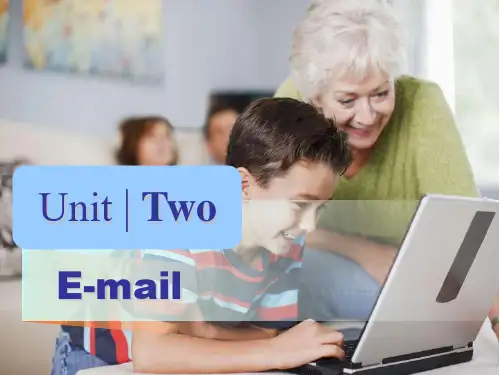
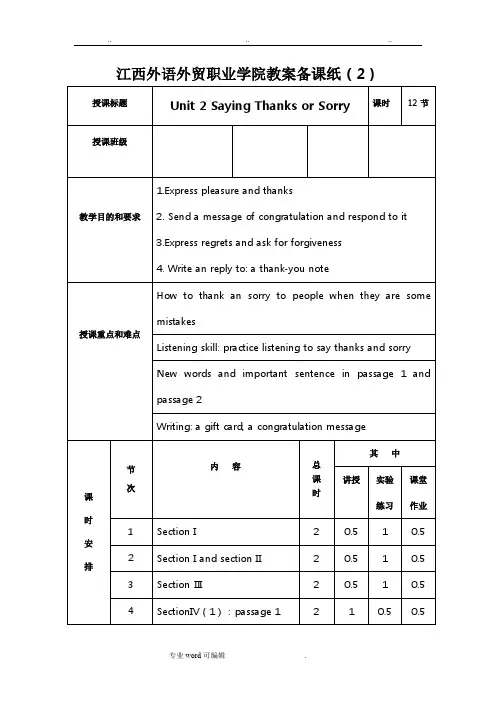
江西外语外贸职业学院教案备课纸(2)江西外语外贸职业学院教案备课纸(3)主任审阅____________________ 授课教师____________________年月日年月日江西外语外贸职业学院教案备课纸(4)授课内容Unit 2Section I Talking Face to FaceThe topic of talking face to face area in this unit is to express thanks andgive responses while exchanging gift-card and congratulation card. The focus is on the patterns that are appropriate for giving information concerning the various reasons and hoping to get the forgiveness from the other person.1. The students read the mini-talks after the teacher, and then try to recite them within five minutes in pairs.2. Ask the students to underline the useful expressions and perform the mini-talks in class.3. The students discuss in groups, summarizing the words, phrases and sentences frequently used according to the following topics with the help of the teacher. The students speak out the sentences under the guidance of the teacher, paying attention to the pronunciation and the intonation.1) sentences frequently used for expressing thanks:It was so generous of you to send me such a fine and beautiful gift.I don’t know how to express my thanks to you.I’m grateful for all the help and encouragement you’ve given me.2) Sentences frequently used for expressing congratulations:Congratulations on your recent promotion!Please accept my heartiest congratulations.江西外语外贸职业学院教案备课纸(3)主任审阅____________________ 授课教师____________________年月日年月日江西外语外贸职业学院教案备课纸(4)授课内容Unit 2Section Ⅱ Being All Ears1. Give the students a few minutes to read through the printed materials for each listening item.2. Listen to the material for the first time without referring to the book.3. Listen to the material for a second time, and ask the students to answer the following questions orally.1) What is the relationship between Andy and Donna?2) What happened to Donna? How does she feel now?3) Why does Donna show her thanks to Andy?4) Where does Andy get the flowers?5) Where does Donna keep the flowers?江西外语外贸职业学院教案备课纸(3)主任审阅____________________ 授课教师____________________年月日年月日江西外语外贸职业学院教案备课纸(4)授课内容Section Ⅲ Trying Your HandApplied WritingSample AnalysisThe teacher summarizes briefly the format and language used in thank-you notes, congratulation cards and apology letters. The teacher may show the following passage with PPT. Afterwards, ask the students to read it and translate it into Chinese orally.1.More information about thank-you notes;Thank-you notes are usually exchanged between friends and acquaintances. They are brief, direct and often in an informal style. They are often written in simple languages, using courteous words and sentences to express the writer’s good wish or thanks. The following sentences are often used in thank-you notes.2.More information about congratulation cards:People often write and send a congratulation card to congratulate one on such joyful occasions as celebrating one’s promotion, wedding, birthday, graduation, etc. Congratulation cards are also exchanged on holidays. The language used in a congratulation card usually sounds courteous and complimentary. The following expressions and sentences often appear in congratulation cards.Grammar2. Do exercises 5,6 and 7 in groups.3.Assignment for this sectionWritten work: suppose you missed an appointment with your friend.Please write a letter of apology for his/her forgiveness.江西外语外贸职业学院教案备课纸(3)主任审阅____________________ 授课教师____________________年月日年月日江西外语外贸职业学院教案备课纸(4)授课内容Unit 2Section Ⅳ(1): Passage 1 Th ank you, Volunteers!rmation Traditional Festivals in China.春节:Spring Festival ( the 1st day of the 1st lunar month)除夕:New Year’s Eve ( the day before the Spring Festival)元宵节:Lantern Festival ( the 15th of the 1st lunar month)清明节:Qingming/Tomb-Sweeping Festival (April 4th or 5th)端午节:Dragon Boat Festival( the 5the of the 5th lunar month)七夕节:Qixi Festival( the 7th day of the 7the month of the lunar month, somewhat equivalent to Valentine’s Day in English)中秋节:Mid-Autumn Festival( the 15th of the 8th lunar month)重阳节:Double-Ninth Day ( the 9th of the 9th lunar month)2.Important Traditional Festivals in Western Countries.圣诞节:Christmas( the 25th of December)平安夜: Christmas Eve ( the 24th of December)情人节:Valentine’s Day ( 14th of February)愚人节:Fool’s Day ( the 1st of April)复活节:Easter( the 1st Sunday after a full moon on or after 21st of Marth) 感恩节:Thanksgiving Day ( the 4th Thursday f November)万圣节:Halloween/All Saints’ Day (31st of October)Important words1.offerv. make available or accessible, provide or furnishe.g. The conference center offers a health spa.The local student offers to guide us around the city.2. invitev. ask someone in a friendly way to do somethinge.g. Shall we invite the famous football player to join our club?Students are invited to submit papers to this online magazine.3. gratefula. feeling or showing thankse.g. He felt so grateful to all the strangers’ help.We need to feel more grateful for what we have instead of complaining what we don’t.4.breakn. a pause from doing something ( as work)e.g. The meeting was too long, so we had a tea break.A 10-minute break between each session offers us a time to resta bit.5. appreciatev. be fully aware of;; realize fullye.g. Do you appreciate the full meaning of this letter?I do appreciate what you have done to ease my pain.6. recognizev. show approval or appreciation ofe.g. Our effort is fully recognized by the society.The in-service training center is widely recognized here.江西外语外贸职业学院教案备课纸(3)主任审阅____________________ 授课教师____________________年月日年月日江西外语外贸职业学院教案备课纸(4)授课内容Unit 2Section Ⅳ(2): Passage 1 Thank you, Volunteers! Language pointsExplanation of Difficult Sentences1. (Para. 1)November in the United States brings the holiday of Thanksgiving, and therefore it’s in November that we tend to think of a way in which we could show our thanks to volunteers.Analysis: This is a complex sentence. The basic sentence structure is S(subject) and S in which…In the second and-clause an emphaticstructure it’s in November is used to emphasize the timeadverbial of in November, modifying we tend to think. Whichleads a relative clause, modifying a way.Translation: 因此,我们在十一月里常常会想办法来表示对志愿者们的感谢。
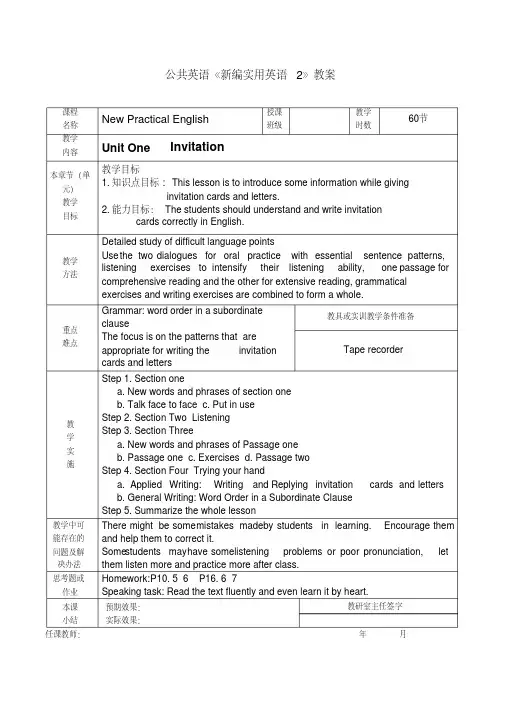
课程名称New Practical English授课班级教学时数60节教学内容Unit One Invitation本章节(单元)教学目标教学目标1.知识点目标: This lesson is to introduce some information while givinginvitation cards and letters.2.能力目标: The students should understand and write invitationcards correctly in English.教学方法Detailed study of difficult language pointsUse the two dialogues for oral practice with essential sentence patterns, listening exercises to intensify their listening ability, one passage for comprehensive reading and the other for extensive reading, grammatical exercises and writing exercises are combined to form a whole.重点难点Grammar: word order in a subordinateclauseThe focus is on the patterns that areappropriate for writing the invitationcards and letters教具或实训教学条件准备Tape recorder教学实施Step 1. Section onea. New words and phrases of section oneb. Talk face to facec. Put in useStep 2. Section Two ListeningStep 3. Section Threea. New words and phrases of Passage oneb. Passage onec. Exercisesd. Passage twoStep 4. Section Four Trying your handa. Applied Writing: Writing and Replying invitation cards and lettersb. General Writing: Word Order in a Subordinate ClauseStep 5. Summarize the whole lesson教学中可能存在的问题及解决办法There might be some m istakes made b y students in learning. Encourage them and help them to correct it.Some students may h ave some l istening problems or poor pronunciation, let them listen more and practice more after class.思考题或作业Homework:P10. 5 6 P16. 6 7Speaking task: Read the text fluently and even learn it by heart.本课小结预期效果:实际效果:教研室主任签字任课教师:年月课程名称New Practical English授课班级教学时数60节教学内容Unit Two Emails本章节(单元)教学目标教学目标1.知识点目标: This lesson is to lead the students to recognize and getemail information on internet.2.能力目标: The students should understand email and know how to writethem correctly by using abbreviation in English教学方法Detailed study of difficult language pointsUse the two dialogues for oral practice with essential sentence patterns, listening exercises to intensify their listening ability, one passage for comprehensive reading and the other for extensive reading, grammatical exercises and writing exercises are combined to form a whole.重点难点The focus is on the patterns that areproperly used in sending and receivingemail in writing.Grammar: Punctuation教具或实训教学条件准备Tape recorder教学实施Step 1. Section onea. New words and phrases of section oneb. Talk face to facec. Put in useStep 2. Section Two ListeningStep 3. Section Threea. New words and phrases of Passage oneb. Passage onec. Exercisesd. Passage twoStep 4. Section Four Trying your handa. Applied Writing: Writing and Replying invitation cards and lettersb. General Writing: Punctuation5. Summarize the whole lessonStep 5. Summarize the whole lesson教学中可能存在的问题及解决办法There might be some m istakes made b y students in learning. Encourage them and help them to correct it.Some students may h ave some l istening problems or poor pronunciation, let them listen more and practice more after class.思考题或作业Homework: P28. 5 6 P34. 3 4 6Speaking task: Read the text fluently and even learn it by heart.本课小结预期效果:实际效果:教研室主任签字任课教师:年月课程名称New Practical English授课班级教学时数60节教学内容Unit Three Communication by phone本章节(单元)教学目标教学目标1.知识点目标: This lesson is to lead the students to take the telephonemessage.2.能力目标: The students should know how to take message i n the officeor at home correctly in English教学方法Detailed study of difficult language pointsUse the two dialogues for oral practice with essential sentence patterns, listening exercises to intensify their listening ability, one passage for comprehensive reading and the other for extensive reading, grammatical exercises and writing exercises are combined to form a whole.重点难点The focus is on the patterns that areappropriate for taking the telephonemessage in the office or at home.Grammar: Noun Clauses教具或实训教学条件准备Tape recorder教学实施Step 1. Section onea. New words and phrases of section oneb. Talk face to facec. Put in useStep 2. Section Two ListeningStep 3. Section Threea. New words and phrases of Passage oneb. Passage onec. Exercisesd. Passage twoStep 4. Section Four Trying your handa. Applied Writing: Writing and Replying invitation cards and lettersb. General Writing: Noun ClausesStep 5. Summarize the whole lesson教学中可能存在的问题及解决办法There might be some m istakes made b y students in learning. Encourage them and help them to correct it.Some students may h ave some l istening problems or poor pronunciation, let them listen more and practice more after class.思考题或作业Homework:P45 . 4 5 6 P52. 5 6Speaking task: Read the text fluently and even learn it by heart.本课小结预期效果:实际效果:教研室主任签字任课教师:年月课程名称New Practical English授课班级教学时数60节教学内容Unit Four Making Reservations本章节(单元)教学目标教学目标1.知识点目标: This lesson is to make reservations.2.能力目标:The students should understand and make reservation correctly in English.教学方法Detailed study of difficult language pointsUse the two dialogues for oral practice with essential sentence patterns, listening exercises to intensify their listening ability, one passage for comprehensive reading and the other for extensive reading, grammatical exercises and writing exercises are combined to form a whole.重点难点The focus of functions is on thepatterns that are appropriate formaking reservations at hotel.Grammar: The Subjunctive Mood教具或实训教学条件准备Tape recorder教学实施Step 1. Section onea. New words and phrases of section oneb. Talk face to facec. Put in useStep 2. Section Two ListeningStep 3. Section Threea. New words and phrases of Passage oneb. Passage onec. Exercisesd. Passage twoStep 4. Section Four Trying your handa. Applied Writing: Writing and Replying invitation cards and lettersb. General Writing: The Subjunctive MoodStep 5. Summarize the whole lesson教学中可能存在的问题及解决办法There might be some m istakes made b y students in learning. Encourage them and help them to correct it.Some students may h ave some l istening problems or poor pronunciation, let them listen more and practice more after class.思考题或作业Homework:P65. 5 6 P72.5 6Speaking task: Read the text fluently and even learn it by heart.本课小结预期效果:实际效果:教研室主任签字任课教师:年月课程名称New Practical English授课班级教学时数60节教学内容Unit Five At a Restaurant本章节(单元)教学目标教学目标1.知识点目标: This lesson is to lead the students to understand and makethe expressions of menu.2.能力目标:The students should understand the menu a nd know how to writeit correctly in English.教学方法Detailed study of difficult language pointsUse the two dialogues for oral practice with essential sentence patterns, listening exercises to intensify their listening ability, one passage for comprehensive reading and the other for extensive reading, grammatical exercises and writing exercises are combined to form a whole.重点难点The focus is on the patterns that areproperly used in talk about the largemeal at a restaurant.Grammar: Relative Clauses教具或实训教学条件准备Tape recorder教学实施Step 1. Section onea. New words and phrases of section oneb. Talk face to facec. Put in useStep 2. Section Two ListeningStep 3. Section Threea. New words and phrases of Passage oneb. Passage onec. Exercisesd. Passage twoStep 4. Section Four Trying your handa. Applied Writing: Writing and Replying invitation cards and lettersb. General Writing: Relative ClausesStep 5. Summarize the whole lesson教学中可能存在的问题及解决办法There might be some m istakes made b y students in learning. Encourage them and help them to correct it.Some students may h ave some l istening problems or poor pronunciation, let them listen more and practice more after class.思考题或作业Homework:P85. 4 5 6 P91. 5 6Speaking task: Read the text fluently and even learn it by heart.本课小结预期效果:实际效果:教研室主任签字任课教师:年月课程名称New Practical English授课班级教学时数60节教学内容Unit Six Shopping本章节(单元)教学目标教学目标1.知识点目标: This lesson is to introduce and learn the different waysof making shopping ads in newspapers and magazines, in theradio and television to promote sales.2.能力目标: The students should understand and know how to write the shopping ads under the instruction, specification, model and functions教学方法Detailed study of difficult language pointsUse the two dialogues for oral practice with essential sentence patterns, listening exercises to intensify their listening ability, one passage for comprehensive reading and the other for extensive reading, grammatical exercises and writing exercises are combined to form a whole.重点难点The focus is on the operatinginstruction, specifications model andfunctionsGrammar: Adverbial Clauses教具或实训教学条件准备Tape recorder教学实施Step 1. Section onea. New words and phrases of section oneb. Talk face to facec. Put in useStep 2. Section Two ListeningStep 3. Section Threea. New words and phrases of Passage oneb. Passage onec. Exercisesd. Passage twoStep 4. Section Four Trying your handa. Applied Writing: Writing and Replying invitation cards and lettersb. General Writing: Adverbial ClausesStep 5. Summarize the whole lesson教学中可能存在的问题及解决办法There might be some m istakes made b y students in learning. Encourage them and help them to correct it.Some students may h ave some l istening problems or poor pronunciation, let them listen more and practice more after class.思考题或作业Homework:P102. 5 6 P109. 5 6Speaking task: Read the text fluently and even learn it by heart.本课小结预期效果:实际效果:教研室主任签字任课教师:年月课程名称New Practical English授课班级教学时数60节教学内容Unit Seven Entertainment and Tourist本章节(单元)教学目标教学目标1.知识点目标: This lesson is to lead the students to the mastery ofrules and principles of entertainment ads.2.能力目标: The students should understand entertainment adsand know how to write them correctly in English.教学方法Detailed study of difficult language pointsUse the two dialogues for oral practice with essential sentence patterns, listening exercises to intensify their listening ability, one passage for comprehensive reading and the other for extensive reading, grammatical exercises and writing exercises are combined to form a whole.重点难点Grammar: Present participle and pastparticiple as attributives教具或实训教学条件准备Tape recorder教学实施Step 1. Section onea. New words and phrases of section oneb. Talk face to facec. Put in useStep 2. Section Two ListeningStep 3. Section Threea. New words and phrases of Passage oneb. Passage onec. Exercisesd. Passage twoStep 4. Section Four Trying your handa. Applied Writing: Writing and Replying invitation cards and lettersb. General Writing: Present participle and past participle asattributivesStep 5. Summarize the whole lesson教学中可能存在的问题及解决办法There might be some m istakes made b y students in learning. Encourage them and help them to correct it.Some students may h ave some l istening problems or poor pronunciation, let them listen more and practice more after class.思考题或作业Homework:P122. Ex. 5 6 P129. 5 6Speaking task: Read the text fluently and even learn it by heart.本课小结预期效果:实际效果:教研室主任签字任课教师:年月课程名称New Practical English授课班级教学时数60节教学内容Unit Eight Farewell本章节(单元)教学目标教学目标1.知识点目标: This lesson is to lead the students to the mastery ofcharacteristics and formula for farewell letter.2.能力目标:The students should understand the characteristic andformula concerning writing a farewell letter.教学方法Detailed study of difficult language pointsUse the two dialogues for oral practice with essential sentence patterns, listening exercises to intensify their listening ability, one passage for comprehensive reading and the other for extensive reading, grammatical exercises and writing exercises are combined to form a whole.重点难点The focus is on the patterns that areappropriate for writing a farewellletterGrammar: Emphasis, Ellipsis andInversion教具或实训教学条件准备Tape recorder教学实施Step 1. Section onea. New words and phrases of section oneb. Talk face to facec. Put in useStep 2. Section Two ListeningStep 3. Section Threea. New words and phrases of Passage oneb. Passage onec. Exercisesd. Passage twoStep 4. Section Four Trying your handa. Applied Writing: Writing and Replying invitation cards and lettersb. General Writing: Emphasis, Ellipsis and InversionStep 5. Summarize the whole lesson教学中可能存在的问题及解决办法There might be some m istakes made b y students in learning. Encourage them and help them to correct it.Some students may h ave some l istening problems or poor pronunciation, let them listen more and practice more after class.思考题或作业Homework:P141. Ex. 4 5 6 P148. 5 6Speaking task: Read the text fluently and even learn it by heart.本课小结预期效果:实际效果:教研室主任签字任课教师:年月课程名称New Practical English授课班级教学时数60节教学内容Unit Nine Applying for a Job本章节(单元)教学目标教学目标1.知识点目标: This lesson is to lead the students to the mastery ofinforming and talking about applying for a job2.能力目标:The students should understand information concerningadvertisements for applying for a job教学方法Detailed study of difficult language pointsUse the two dialogues for oral practice with essential sentence patterns, listening exercises to intensify their listening ability, one passage for comprehensive reading and the other for extensive reading, grammatical exercises and writing exercises are combined to form a whole.重点难点The focus of functions therefore is onthe patterns that are appropriate forgiving information concerning applyingfor a job. Grammar: word order in asubordinate clause教具或实训教学条件准备Tape recorder教学实施Step 1. Section onea. New words and phrases of section oneb. Talk face to facec. Put in useStep 2. Section Two ListeningStep 3. Section Threea. New words and phrases of Passage oneb. Passage onec. Exercisesd. Passage twoStep 4. Section Four Trying your handa. Applied Writing: Writing and Replying invitation cards and lettersb. General Writing: Word Order in a Subordinate ClauseStep 5. Summarize the whole lesson教学中可能存在的问题及解决办法There might be some m istakes made b y students in learning. Encourage them and help them to correct it.Some students may h ave some l istening problems or poor pronunciation, let them listen more and practice more after class.思考题或作业Homework:Ex. 5 6 P170. 6Speaking task: Read the text fluently and even learn it by heart.本课小结预期效果:实际效果:教研室主任签字任课教师:年月课程名称New Practical English授课班级教学时数60节教学内容Unit Ten Managers and CEOS本章节(单元)教学目标教学目标1.知识点目标: This lesson is to lead the students to the mastery ofinforming and talking about conference schedules2.能力目标:The students should understand the format and informationconcerning preparing a conference or an agenda.教学方法Detailed study of difficult language pointsUse the two dialogues for oral practice with essential sentence patterns, listening exercises to intensify their listening ability, one passage for comprehensive reading and the other for extensive reading, grammatical exercises and writing exercises are combined to form a whole.重点难点The focus of functions is on the specialformat and relevant terms andexpressions that are appropriate fortalking about planning a conference.Grammar: Conclusion教具或实训教学条件准备Tape recorder教学实施Step 1. Section onea. New words and phrases of section oneb. Talk face to facec. Put in useStep 2. Section Two ListeningStep 3. Section Threea. New words and phrases of Passage oneb. Passage onec. Exercisesd. Passage twoStep 4. Section Four Trying your handa. Applied Writing: Writing and Replying invitation cards and lettersb. General Writing: ConclusionStep 5. Summarize the whole lesson教学中可能存在的问题及解决办法There might be some m istakes made b y students in learning. Encourage them and help them to correct it.Some students may h ave some l istening problems or poor pronunciation, let them listen more and practice more after class.思考题或作业Homework:P183. Ex. 5 6 P191. 5 6Speaking task: Read the text fluently and even learn it by heart.本课小结预期效果:实际效果:教研室主任签字任课教师:年月。
Unit 2 Communication by EmailUnit GoalsWhat you should learn to do1.Chat onlinee abbreviations and slangs in communicating online3.Write an emailWhat you should know about1.Surfing online for:InformationShopping2.Good or bad of chatting online3.Noun clausesSection I Talking Face to Face1.Imitating Mini-Talks2.Acting out the Tasks3.Studying Email Information on the Internet4.Following Sample Dialogues5.Putting Language to UseSection II Being All Ears1.Learning Sentences for Workplace Communication2.Handling a Dialogue3.Understanding a Short Speech / TalkSection III Trying your Hand1.Practicing Applied Writing2.Writing Sentences and Reviewing Grammar Section IV Maintaining a Sharp EyePassage 1 :Information Related to the Reading PassageIt’s no understatement to say that e-mail has had a profound effect on our professional and personal lives. People thousands of miles away from each other can send and receive detailed documents within mere seconds. This allows us to take on projects that wouldn’t have been practical or possible only a few years ago. It has become routine for us to correspond and exchange files with people overseas. The only obstacle is the difference in time zones.But on the other hand, e-mail can eat up a substantial portion of our workday. Most of the time and effort involved is going through unsolicited messages and separating the good from the bad. But not all unsolicited messages are spam.Text E-mail, a Blessing and AnnoyanceFor the blessing:E-mail is a conversation that does not require an immediate response (like a telephone). If someone calls you on the telephone, you pick it up (unless you have an answering machine, voice mail or you are just plain rude) and the conversation begins. This is an interactive conversation.With e-mail, you send a message and then wait for a response. The response may come in five minutes or it may come in five days. Either way, it’s not an interactive conversation.If a hundred people send you e-mails in one day, so what? You don’t have to talk with all one hundred. Just think of all the hellos, goodbyes and other unnecessary chit-chat you can avoid. With e-mail, you only deal with their messages (which usually omit hellos, goodbyes and such) and you deal with them on your own time. That’s the blessing.Now for the annoyance:Too many e-mail users assume that the minute someone receives an e-mail, the person will read it. Bad assumption.If you schedule a meeting for an hour from now and send an e-mail to eachparticipant, the chance that all the participants will read that message within the hour will be pretty small. On the other hand, if you schedule the meeting for the next day, the chance that they will read the message will be pretty high. Remember, e-mail is not designed for immediate response (that’s why you have a telephone), it’s designed for convenience.Some (not all) e-mail systems have features that try to combat this problem. These features (usually called “notification”) will notify you when a person has received your e-mail and may also tell you when the person has read it (really all it can do is assure you that the person has looked at the first screen of the message —it has no way to know if the person has read the message word for word). Referring back to the example in the previous paragraph, you could check to see who has checked their e-mail before the meeting and then telephone those who have not read it.Attachment: SmiliesSince there are no facial and voice cues to help e-mail, users have come up with something called “smilies”. They are simple series of symbols that are pieced together in the e-mail text to help express the writer’s feelings. The most common example is :-) (a smiling face). Here are some more examples.They are typically found at the end of sentences and will usually refer back to the previous statement.Language Points1 Explanation of Difficult Sentences1. (Para. 3) If a hundred people send you e-mail in one day, so what?Analysis: so what? is an informal expression, which means “Why should I care?”Translation: 如果在一天内有一百个人给你发邮件,那又怎么样呢?2. (Para. 3) Just think of all the hellos, good-byes and other unnecessary chit-chat you could avoid.Analysis: Just is used to make a statement or command stronger, meaning in Chinese“只是,仅仅”。
江西外语外贸职业学院教案备课纸(2)授课标题Unit 2 Saying Thanks or Sorry 课时12 节授课班级1.Express pleasure and thanks教学目的和要求2. Send a message of congratulation and respond to it3.Express regrets and ask for forgiveness4. Write an reply to: a thank-you noteHow to thank an sorry to people when they are some mistakes Listening skill: practice listening to say thanks and sorry授课重点和难点New words and important sentence in passage 1 and passage 2Writing: a gift card; a congratulation message总其中节次内容课时讲授实验练习课堂作业1 Section I2 0.5 1 0.52 Section I and section II 2 0.5 1 0.5课3 SectionⅢ 2 0.5 1 0.5 时4 SectionⅣ(1):passage 1 2 1 0.5 0.5 安5 SectionⅣ(2):passage 1 2 1 0.5 0.5 排6 SectionⅣ:Passage2 2 1 0.5 0.5SectionⅤ: Cultural tips合计12 节 4.5 4.5 3江西外语外贸职业学院教案备课纸(3)授课标题Unit 2 SectionⅠTalking Face to Face 课时 2How to thank and sorry to each other when people mistake something. 教学重点与难点复习旧Review the way to say hi.课内容教学方法Lecture;Act out in groups;Act out : Let the students practice the expression of thank and sorry to 作业布置others in class.课堂小结课堂效果分析及改进措施主任审阅____________________ 授课教师____________________年月日年月日江西外语外贸职业学院教案备课纸(4)授课内容Unit 2Section I Talking Face to FaceThe topic of talking face to face area in this unit is to express thanks and give responseswhile exchanging gift-card and congratulation card. The focus is on the patterns that are appropriate for giving information concerning the various reasons and hoping to get the forgiveness from the other person.5. The students read the mini-talks after the teacher, and then try to recite them within five minutes in pairs.6. Ask the students to underline the useful expressions and perform the mini-talks in class.7.The students discuss in groups, summarizing the words, phrases and sentences frequently used according to the following topics with the help of the teacher. The students speak out the sentences under the guidance of the teacher, paying attention to the pronunciation and the intonation.1) sentences frequently used for expressing thanks:It was so generous of you to send me such a fine and beautiful gift.I don’t know how to express my thanks to you.I ’m grateful for all the help and encouragement you’ve given me.2) Sentences frequently used for expressing congratulations:Congratulations on your recent promotion!Please accept my heartiest congratulations.江西外语外贸职业学院教案备课纸(3)Unit 2 SectionⅠTalking Face to Face授课标题SectionⅡBeing All Ears 课时 2Useful expressions for thanking and saying sorry to others教学重点与难点复习旧课内容Sentences which can be used to express appreciation教学方法Lecture;Act out in groups;作业布置Get more familiar with those useful expressions课堂小结课堂效果分析及改进措施主任审阅____________________ 授课教师____________________年月日年月日江西外语外贸职业学院教案备课纸(4)授课内容Unit 2SectionⅡBeing All Ears8.Give the students a few minutes to read through the printed materials for each listening item.9. Listen to the material for the first time without referring to the book.10.Listen to the material for a second time, and ask the students to answer the following questions orally.1) What is the relationship between Andy and Donna?2) What happened to Donna? How does she feel now?3) Why does Donna show her thanks to Andy?4) Where does Andy get the flowers?5) Where does Donna keep the flowers?江西外语外贸职业学院教案备课纸(3)授课标题Unit 2 SectionⅢTrying Your Hand 课时 2 教学重点1. How to write a thank-you note in English2. Sentence structure practice与难点复习旧课内容Review how to say hi to each other when they meet.教学方法Lecture; The task-based teaching method;作业布置Translate a not into chinese (P33)课堂小结课堂效果分析及改进措施主任审阅____________________ 授课教师____________________年月日年月日江西外语外贸职业学院教案备课纸(4)授课内容SectionⅢTrying Your HandApplied WritingSample AnalysisThe teacher summarizes briefly the format and language used in thank-you notes, congratulation cards and apology letters. The teacher may show the following passage with PPT. Afterwards, ask the students to read it and translate it into Chinese orally. 11.More information about thank-you notes;Thank-you notes are usually exchanged between friends and acquaintances. They are brief, direct and often in an informal style. They are often written in simple languages, using courteous words and sentences to express the wri’t sergood wish or thanks. The following sentences are often used in thank-you notes.12.More information about congratulation cards:People often write and send a congratulation card to congratulate one on such joyful occasions as celebrating one’s promotion, wedding, birthday, graduation, etc. Congratulation cards are also exchanged on holidays. The language used in a congratulation card usually sounds courteous and complimentary. The following expressions and sentences often appear in congratulation cards.GrammarPractice 1:Types Usages Examples Definite A definite article indicates that its noun is a The children article ( The) particular one( or ones) identifiable to the listener. know the fastest It may be the same thing that the speaker has way home.already mentioned, or it may be something Give me theuniquely specified. book.Indefinite An indefinite article indicates that its noun is not She had so large article( A/An) a particular one ( or ones ) identifiable to the a house that an listener. It may be something that the speaker is elephant wouldmentioning for the first time, or its precise get lost without aidentity may be irrelevant or hypothetical, or the map.speaker may be making a general statement aboutany such thing.13. Do exercises 5,6 and 7 in groups.14.Assignment for this sectionWritten work: suppose you missed an appointment with your friend. Please write a letter of apology for his/her forgiveness.江西外语外贸职业学院教案备课纸(3)Unit 1 SectionⅣ(1): Passage 1授课标题Thank you, Volunteers! 课时 215. analyze passage 1 教学重点16. explain the new words and important words与难点复习旧课内容review the format of thank-you note.教学方法Lecture; The situational teaching method;作业布置1. Read and complete (P38) review the useful words课堂小结课堂效果分析及改进措施主任审阅____________________ 授课教师____________________年月日年月日江西外语外贸职业学院教案备课纸(4)授课内容Unit 2SectionⅣ(1): Passage 1 Thank you, Volunteers!rmation Traditional Festivals in China.st day of the 1st lunar month) 春节:Spring Festival ( the1除夕:New Year’s Eve ( the day before the Spring Festival)th of the 1st lunar month) 元宵节:Lantern Festival ( the15th or 5th) 清明节:Qingming/Tomb-Sweeping Festival (April4th lunar month) 端午节:Dragon Boat Festival( the 5the of the5七夕节:Qixi Festival( the 7 th day of the 7the month of the lunar month, somewhat equivalent to Valentine’s Day in English)th of the 8th lunar month) 中秋节:Mid-Autumn Festival( the15th of the 9th lunar month) 重阳节:Double-Ninth Day ( the918.Important Traditional Festivals in Western Countries.th of December) 圣诞节:Christmas( the25th of December) 平安夜: Christmas Eve ( the24th of February) 情人节:Valentine’s Day( 14st of April) 愚人节:Fool’s Day ( the1st Sunday after a full moon on or after 21st of Marth) 复活节:Easter( the1th Thursday f November) 感恩节:Thanksgiving Day ( the4st of October) 万圣节:Halloween/All Saints’Day(31Important words2. offerv. make available or accessible, provide or furnishe.g. The conference center offers a health spa.The local student offers to guide us around the city.3. invitev. ask someone in a friendly way to do somethinge.g. Shall we invite the famous football player to join our club?Students are invited to submit papers to this online magazine.19. gratefula. feeling or showing thankse.g. He felt so grateful to all the strangers’h elp.We need to feel more grateful for what we have instead of complaining what we don’t.20.breakn. a pause from doing something ( as work)e.g. The meeting was too long, so we had a te b a reak.A 10-minute break between each session offers us a time to rest a bit.21. appreciatev. be fully aware of;; realize fullye.g. Do you appreciate the full meaning of this letter?I do appreciate what you have done to ease my pain.22. recognizev. show approval or appreciation ofe.g. Our effort is fully recognized by the society.The in-service training center is widely recognized here.江西外语外贸职业学院教案备课纸(3)Unit 1 Section Ⅳ(2): Passage 1授课标题Thank you, Volunteers! 课时 223. analyze passage 1 教学重点24. explain the difficult sentences与难点复习旧课内容review the key words教学方法Lecture; The situational teaching method;作业布置4.Read and translate (P39) preview passage 2课堂小结课堂效果分析及改进措施主任审阅____________________ 授课教师____________________年月日年月日江西外语外贸职业学院教案4)备课纸(内容授课Unit 2Section Ⅳ(2): Passage 1 Thank you, Volunteers!Language pointsExplanation of Difficult Sentences25. (Para. 1) November in the United States brings the holiday of Thanksgiving, and therefore it’s in November that we tend to think of a way in which we could show our thanks to volunteers.Analysis:This is a complex sentence. The basic sentence structure is S(subject) and S in which⋯In the secondand-clause an emphatic structureit’s inNovemberis used to emphasize the time adverbial of in November,modifying we tend to think. Which leads a relative clause, modifyinga way.Translation: 因此,我们在十一月里常常会想办法来表示对志愿者们的感谢。
Unit 2 Saying Thanks or SorryUnit Goals:What You Should Learn Do1. Express pleasure and thanks2. Send a message of congratulation and respond to it3. Express regrets and ask for forgiveness4. Write and reply to:a thank-you notea gift carda congratulation messageWhat You Should Know About1. Feeling thankful and sorry is part of your culture2. Being serious when saying sorry3. Use of articlesSection ⅠTalking Face to FaceImitating Mini-Talks Speak and ReciteActing out the Tasks Speak and PerformStudying Gift and Congratulation Cards Study and ImitateFollowing Sample Dialogues Imitate and PerformPutting Language to Use Speak and Complete Speak and Communicate SECTION IV Maintaining a Sharp EyePASSAGE IInformation Related to the Reading PassageImportant Traditional Festivals in China春节:Spring Festival (the 1st day of the 1st lunar month)除夕:New Year's Eve (the day before the Spring Festival)元宵节:Lantern Festival (the 15th of the 1st lunar month)清明节:Qingming / Tomb-Sweeping Festival (April 4th or 5th)端午节:Dragon Boat Festival (the 5th of the 5th lunar month)七夕节:Qixi Festival (the 7th day of the 7th month of the lunar month, somewhat equivalent to V alentine's Day in English)中秋节:Mid-Autumn Festival (the 15th of the 8th lunar month)重阳节:Double-Ninth Day (the 9th of the 9th lunar month)Important Traditional Festivals in Western Countries圣诞节:Christmas (the 25th of December)平安夜:Christmas Eve (the 24th of December)情人节:V alentine's Day (14th of February)愚人节:Fool's Day (the 1st of April)复活节:Easter (the 1st Sunday after a full moon on or after 21st of March)感恩节:Thanksgiving Day (the 4th Thursday of November)万圣节:Halloween / All Saints' Day (31st of October)Language PointsI Explanation of Difficult Sentences1. (Para. 1) November in the United States brings the holiday of Thanksgiving, and therefore it's in November that we tend to think of a way in which we could show our thanks to volunteers.Analysis: This is a complex sentence. The basic sentence structure is S (Subject) and S in which .... In the second and-clause an emphatic structure it's in November is used to emphasize the time adverbial of in November, modifying we tend to think. Which leads a relative clause, modifying a way.Translation: 因此,我们在十一月里常常会想办法来表示对志愿者们的感谢。
江西外语外贸职业学院教案备课纸(2)江西外语外贸职业学院教案备课纸(3)主任审阅____________________ 授课教师____________________ 年月日年月日江西外语外贸职业学院教案备课纸(4)授课内容Unit 2Section I Talking Face to FaceThe topic of talking face to face area in this unit is to express thanks and give responses while exchanging gift-card and congratulation card. The focus is on the patterns that are appropriate for giving information concerning the various reasons and hoping to get the forgiveness from the other person.1. The students read the mini-talks after the teacher, and then try to recite them within five minutes in pairs.2. Ask the students to underline the useful expressions and perform the mini-talks in class.3. The students discuss in groups, summarizing the words, phrases and sentences frequently used according to the following topics with the help of the teacher. The students speak out the sentences under the guidance of the teacher, paying attention to the pronunciation and the intonation.1) sentences frequently used for expressing thanks:It was so generous of you to send me such a fine and beautiful gift.I don’t know how to express my thanks to you.I’m grateful for all the help and encouragement you’ve given me.2) Sentences frequently used for expressing congratulations:Congratulations on your recent promotion!Please accept my heartiest congratulations.江西外语外贸职业学院教案备课纸(3)主任审阅____________________ 授课教师____________________ 年月日年月日江西外语外贸职业学院教案备课纸(4)授课内容Unit 2Section Ⅱ Being All Ears1. Give the students a few minutes to read through the printed materials for each listening item.2. Listen to the material for the first time without referring to the book.3. Listen to the material for a second time, and ask the students to answer the following questions orally.1) What is the relationship between Andy and Donna?2) What happened to Donna? How does she feel now?3) Why does Donna show her thanks to Andy?4) Where does Andy get the flowers?5) Where does Donna keep the flowers?江西外语外贸职业学院教案备课纸(3)主任审阅____________________ 授课教师____________________ 年月日年月日江西外语外贸职业学院教案备课纸(4)授课内容Section Ⅲ Trying Y our HandApplied WritingSample AnalysisThe teacher summarizes briefly the format and language used in thank-you notes, congratulation cards and apology letters. The teacher may show the following passage with PPT. Afterwards, ask the students to read it and translate it into Chinese orally. 1.More information about thank-you notes;Thank-you notes are usually exchanged between friends and acquaintances. They are brief, direct and often in an informal style. They are often written in simple languages, using courteous words and sentences to express the writer’s good wish or thanks. The following sentences are often used in thank-you notes.2.More information about congratulation cards:People often write and send a congratulation card to congratulate one on such joyful occasions as celebrating one’s promotion, wedding, birthday, graduation, etc. Congratulation cards are also exchanged on holidays. The language used in a congratulation card usually sounds courteous and complimentary. The following expressions and sentences often appear in congratulation cards.Grammar3.Assignment for this sectionWritten work: suppose you missed an appointment with your friend. Please write a letter of apology for his/her forgiveness.江西外语外贸职业学院教案备课纸(3)主任审阅____________________ 授课教师____________________ 年月日年月日江西外语外贸职业学院教案备课纸(4)授课内容Unit 2Section Ⅳ(1): Passage 1 Thank you, Volunteers!rmation Traditional Festivals in China.春节:Spring Festival ( the 1st day of the 1st lunar month)除夕:New Year’s Eve ( the day before the Spring Festival)元宵节:Lantern Festival ( the 15th of the 1st lunar month)清明节:Qingming/Tomb-Sweeping Festival (April 4th or 5th)端午节:Dragon Boat Festival( the 5the of the 5th lunar month)七夕节:Qixi Festival( the 7th day of the 7the month of the lunar month, somewhat equivalent to Valentine’s Day in English)中秋节:Mid-Autumn Festival( the 15th of the 8th lunar month)重阳节:Double-Ninth Day ( the 9th of the 9th lunar month)2.Important Traditional Festivals in Western Countries.圣诞节:Christmas( the 25th of December)平安夜: Christmas Eve ( the 24th of December)情人节:Valentine’s Day ( 14th of February)愚人节:Fool’s Day ( the 1st of April)复活节:Easter( the 1st Sunday after a full moon on or after 21st of Marth)感恩节:Thanksgiving Day ( the 4th Thursday f November)万圣节:Halloween/All Saints’ Day (31st of October)Important words1.offerv. make available or accessible, provide or furnishe.g. The conference center offers a health spa.The local student offers to guide us around the city.2. invitev. ask someone in a friendly way to do somethinge.g. Shall we invite the famous football player to join our club?Students are invited to submit papers to this online magazine.3. gratefula. feeling or showing thankse.g. He felt so grateful to all the strangers’ help.We need to feel more grateful for what we have instead of complaining what we don’t.4.breakn. a pause from doing something ( as work)e.g. The meeting was too long, so we had a tea break.A 10-minute break between each session offers us a time to rest a bit.5. appreciatev. be fully aware of;; realize fullye.g. Do you appreciate the full meaning of this letter?I do appreciate what you have done to ease my pain.6. recognizev. show approval or appreciation ofe.g. Our effort is fully recognized by the society.The in-service training center is widely recognized here.江西外语外贸职业学院教案备课纸(3)主任审阅____________________ 授课教师____________________ 年月日年月日江西外语外贸职业学院教案备课纸(4)授课内容Unit 2Section Ⅳ(2): Passage 1 Thank you, Volunteers!Language pointsExplanation of Difficult Sentences1. (Para. 1)November in the United States brings the holiday of Thanksgiving, and therefore it’s in November that we tend to think of a way in which we could show our thanks to volunteers.Analysis: This is a complex sentence. The basic sentence structure is S(subject) and S in which…In the second and-clause an emphatic structure it’s inNovember is used to emphasize the time adverbial of in November,modifying we tend to think. Which leads a relative clause, modifyinga way.Translation: 因此,我们在十一月里常常会想办法来表示对志愿者们的感谢。